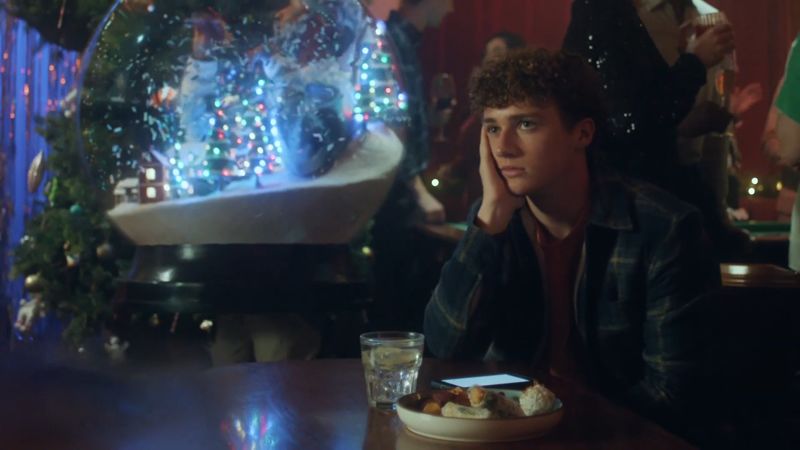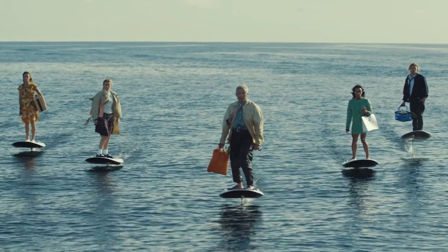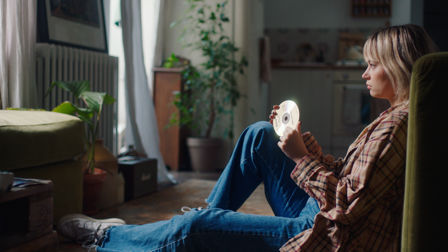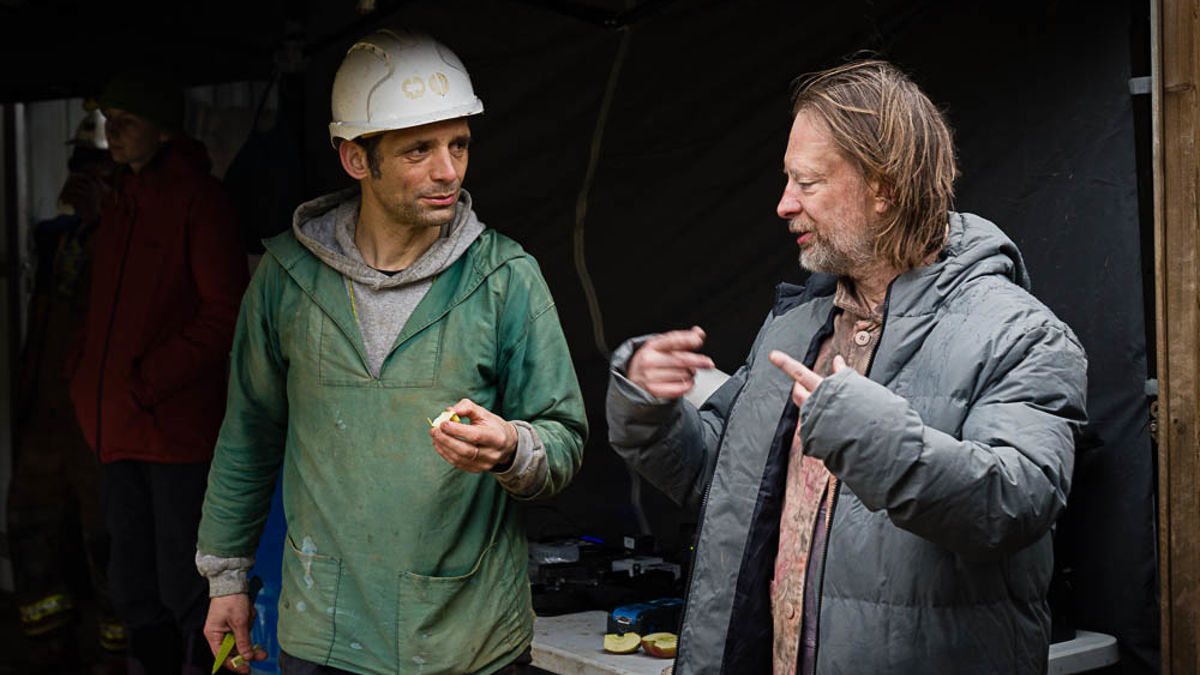Mark Jenkin mines promo gold for Thom Yorke
BAFTA-winning director Mark Jenkin has helmed a new promo for Thom Yorke-fronted band The Smile which takes the director, crew and singer down a 200 foot Cornish mine for an ethereal , black-and-white video.
Thom Yorke is no stranger to unusual, ethereal music videos, with Radiohead having created a number of iconic promos over the years.
Here, Yorke collaborates with Bullion director Mark Jenkin on a promo for the former's Covid-borne band, The Smile.
Jenkin, who won a BAFTA in 2020 in the Outstanding Debut by a British Writer, Director or Producer category, is well known for his hand-crafted, atmospheric, black-and-white approach to filmmaking, and with Skirting on the Surface, which was filmed 200 feet down an abandoned Cornish mine, has created a beautifully unusual piece of work with Yorke in the starring role.
Below, you can see the new video and hear from Jenkin as he discusses his process, the challenges of shooting in such a remote location, and why he loves "the physicality of the medium" of film.
Credits
powered by
-
- Production Company Bullion Productions
- Director Mark Jenkin
-
-
Unlock full credits and more with a Source + shots membership.
Credits
powered by
- Production Company Bullion Productions
- Director Mark Jenkin
- Executive Producer Joel Spencer
- Managing Director Jack Newman
- Production Designer Joe Gray

Credits
powered by
- Production Company Bullion Productions
- Director Mark Jenkin
- Executive Producer Joel Spencer
- Managing Director Jack Newman
- Production Designer Joe Gray
Above: Jenkin's promo for The Smile's Skirting on the Surface, shot in a 200 foot deep abandoned Cornish mine.
What appealed to you about this project to want to take it on?
MJ: To be honest, it was no-brainer when considering who was asking. Also, the music is so cinematic. There’s always an ambiguity there that leaves room for something else in the visuals, meaning that there is never a temptation to do anything literal. That's a great starting point as far as I’m concerned. You only have to look back at the music videos associated with the band members to see how much the music lends itself to being married to imagery.
At the first meeting [I] said I didn’t really have any specific ideas, which isn’t unusual at the early stage, but I did have a location in mind, which they liked the sound of.
My filmmaking is always heavily reliant on sound design, which I like to do myself so, often when I’m making a music video, I feel like half of my tools have been taken away. It’s not the case with this band. The music gives you so much to work with.
How did you pitch this idea to Thom Yorke and The Smile?
MJ: I was quite frank at the first meeting and said I didn’t really have any specific ideas, which isn’t unusual at the early stage, but I did have a location in mind, which they liked the sound of. I then created a 10-minute taster film made up of archive footage, examples of my work, shots from the location, and various other proof of concept bits, and then talked over the top, explaining what I intended to do. I find that’s the simplest and most effective way to communicate my ideas; pictures and sounds.

Above: Jenkin, left, with Yorke.
What made you decide to base the promo at this particular location and how much of that decision, if any, had to do with the track itself?
MJ: Very little. I’d formulated this idea for the previous track that the band had released, but we ended up doing it for it this one instead. The images and montage I had in mind were really not specific to the lyrics as, in the early conversations I had with the band, we were all keen for the video to not be literal, or even narrative driven. The location was the starting point and although it wasn’t specific to the track in any way, in the end some odd coincidences emerged in relation to the lyrics and the images. It was obviously meant to be.
The song has an ethereal quality; do you think that's mirrored by the mine?
MJ: I’m not sure. Ultimately you can shoot any location in an infinite number of ways. The footage of the mine looks and feels nothing like how we experienced it on the day. For example, it was lit very brightly and there were concerns (from myself included) that it looked too much like a studio set. But the camera, especially working with small gauge film, sees the space in a very different way. 16mm has beautiful limitations that the eye usually normalises.
The location is staggering. Being that far underground is otherworldly if you’re not used to it, but it’s not a given that you can capture that other-worldliness on film.
The location is staggering though. Being that far underground [the mine is 200 feet deep] is otherworldly if you’re not used to it, but it’s not a given that you can capture that other-worldliness on film. It’s all about how you shoot it, how you process it, how you assemble it and how that cut combines with, confirms, and contradicts the music. The location is a starting point but it’s a blank canvass in terms of atmosphere.
The ‘ethereal' comes from the way in which the sounds and pictures intersect. That is the magic of filmmaking. For me, the mine is a brutal space. It just smacks of hard work. Obviously there’s a beauty in that, but there’s also a toughness. I also think there’s a toughness in the song. So, maybe that’s where the mirroring came. The thing that jumped out for me was the production; the reverb on the track. That was, sonically, very reminiscent of being in the mine. The natural reverb in some of the tunnels is insane. I’m sure you can hear conversations bouncing around down there that happened years ago. There was a real synergy between being underground and the production on the track. We played the track when we were shooting and it sounded incredible.
Above: More behind the scenes images from the shoot of Skirting the Water.
What was Thom's initial reaction; was he immediately on board?
MJ: I think all the band liked the idea of the mine as a location. That was the hook. So, yeah, Thom was really behind it from the start. He wasn’t originally going to be in the video but as I progressed with the idea, and seeing him more and more in the old videos, I realised it had to be him. Every performance is motivated by subtext. I assume Thom knows the meaning of the track, or at least where it came from, so I knew he would automatically imbue what he was doing with subtext no matter what physical direction I was giving him.
Thom was game, and a total pleasure to work with. It’s no revelation for me to say that he is a really compelling screen presence.
If I had worked with an actor the subtext would have had to come from elsewhere. That’s not to say it wouldn’t have worked but I like the idea that there is a lot going on inside the head of the miner whilst this tough, physical task is being completed. Thom was game, and a total pleasure to work with. It’s no revelation for me to say that he is a really compelling screen presence.
Radiohead have some iconic music videos in their back catalogue; was that fact intimidating?
MJ: Yes. It was really intimidating at first. I knew a lot of the videos anyway, but I went back and watched them all in one go. What quickly became apparent was how much freedom the directors had all been given, and that allayed any worries I had. I did avoid watching the film Thom made with PT Anderson for Anima until I’d finished the cut for this one though.
Credits
powered by
-
-
- Director Jamie Thraves
-
-
Unlock full credits and more with a Source + shots membership.
Credits
powered by
- Director Jamie Thraves
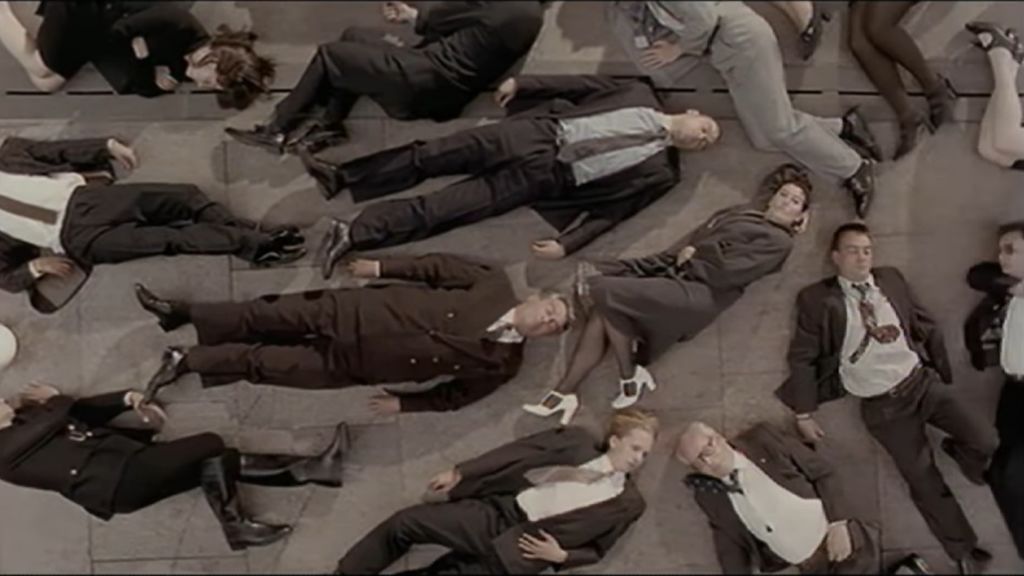
Credits
powered by
- Director Jamie Thraves
Above: Just, one of Radiohead's iconic promos.
Were there any misgivings about filming in the mine?
MJ: No, not really. I’d been in the mine many times before and I knew what a great environment it is. The thought of being that far underground in a cramped space is more unnerving than the actual reality. It’s so peaceful in there. The bonus is that you don’t have any weather worries. We shot during Storm Eunice and Storm Franklin and while up on the surface the place was being blown to pieces, we were blissfully unaware.
We shot during Storm Eunice and Storm Franklin and while up on the surface the place was being blown to pieces, we were blissfully unaware.
It’s also a complete blank canvass when it comes to lighting. You have the control of a studio but the inbuilt production design and mise-en-scene of a location. We’d shot a brief scene for my latest movie down there and I felt like I had unfinished business with it as a location. I’d actually been thinking about going back in and taking some stills, using a single light source, and then trying to process the negatives with the water that runs through the shafts there, and seeing how that came out. When the band got in touch and I was scaling around for an idea, I thought maybe I could turn that stills idea into something moving.

Above: Jenkin and lighting technician, Colin Holt, hung festoon lights in the mine.
Can you explain a bit about the filming process, what camera/film stock you used and why?
MJ: I shoot on 16mm black and white negative using a clockwork Bolox H16. I then hand-process the negative in my studio and usually interfere with it in some way. On this occasion I solarised parts of the film by flashing the negative during processing with a torch. I often mix my own developer from powder, and for this batch I used water that I took out of the mine to complete the solution, complete with all the grit, mud and minerals that come with it.
I like the problem solving element of editing; looking for unusual ways to cut sequences that you don’t stumble upon if you have wall-to-wall coverage.
You can see quite a lot of that in the finished piece. I under-exposed the neg by about three stops and then really pushed it in the processing. I also used some old stock that had been flashed to get a really flat image which I could then push to breaking point in the grade. The final element was a 100ft of film that I partially bled the emulsion of with household bleach and sulphuric acid and then, once washed and dried, etched Thom's lyrics into it with a knife. This was a call back to what I’d done for the previous video for the band called The Smoke.
What is it about this particular style of filmmaking that resonates with you?
MJ: I love the practical side of filmmaking. I like the physicality of the medium but also physicality of the work flow. The more time I spend away from the computer the better for me. Shooting on film means I don’t shoot too much, which is really great when it gets to the edit. I like the problem solving element of editing; looking for unusual ways to cut sequences that you don’t stumble upon if you have wall-to-wall coverage. I also like to keep the shoot as simple as possible. As far as the camera department goes, it’s just me and my assistant, a camera, a lens, a light metre, and a few rolls of film. There’s no baggage.
Credits
powered by
-
- Production Company Bullion Productions
- Director Mark Jenkin
-
-
Unlock full credits and more with a Source + shots membership.
Credits
powered by
- Production Company Bullion Productions
- Director Mark Jenkin
- Producer Joel Spencer

Credits
powered by
- Production Company Bullion Productions
- Director Mark Jenkin
- Producer Joel Spencer
Above: Jenkin's previous video for The Smile for the track, The Smoke.
What were the main challenges on the shoot?
MJ: As always, the main challenge is time and money. This one was no different. A fine balance has to be struck. You need enough time and money to do justice to the idea but you don’t want too much that you become complacent. I have to be living on my wits to do my best work so I’m not someone who is always asking for more, more, more. The production got it spot on this time.
As always, the main challenge is time and money. This one was no different.
On a practical level there are challenges. Getting kit in and out of a mine takes time. The art department, led by production designer Joe Gray, did an incredible job as we moved along the shafts, striking and building sets on a tight schedule in cramped conditions. Joe's determination and ingenuity is a constant inspiration. I decided to shoot the whole thing hand-held, which is rare for me, so we could run and gun as much as possible. It was mostly shot on a 10mm prime to give me more freedom. It was two days of hanging off the mine-cart, crawling into crevices and going up and down ladders getting the angles that were needed.
The lighting was conceptually simple but logistically complicated. We ran hundreds of metres of practical festoon lights (from a builders merchants) through the mine and then augmented that with mostly handheld lamps. As always, Colin Holt, who lights for me, worked wonders with the slenderest of means. The other challenge was communication. Phones and radios are useless in the mine so all communication with the surface was done by foot which has certain implications for the schedule.
Above: The trailer for Jenkin's BAFTA-winning 2019 film, Bait.
What are you working on next, and do you plan to direct and more music videos?
MJ: I’ve just finished the follow-up to Bait; a horror film called Enys Men, which should be in cinemas later this year. I imagine I'll continue making music videos if the right opportunities arise. I find the short turnaround a nice contrast to the slow world of feature films. I’ve always made short films as a way of experimenting with different forms of storytelling or non-narrative communication and I don’t see music videos as being any different to that.
)
